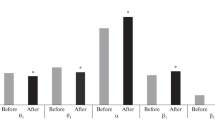A total of 105 control operators at the Kursk nuclear power station were studied: 45 after working shifts (study group) and 60 on rest days (reference group). These investigations showed that operators’ work shifts had significant influences on the functional state of the nervous system, promoting the appearance or exacerbation of autonomic dysfunction. In some cases, work shifts increased arterial blood pressure to risk levels for the development of cerebrovascular disease. The effects of nuclear power station operators’ work shifts on brain bioelectrical activity included a decrease in the proportion of unaltered EEG traces, along with increases in the spectral power densities of the α rhythm in the parietal leads and the θ rhythm in the posterior temporal and parietal leads. The origin of these changes may be related to both fatigue and the effects of adverse industrial factors. It is suggested that clinical observation of power station operators should be supplemented by assessments of autonomic dysfunction and measurement of the spectral power densities of the α and θ rhythms in the parietal and posterior temporal leads.
Similar content being viewed by others
References
T. Z. Biktimirov, “Neurological and psychosomatic disorders in medical staff of ‘critical’ specialties in conditions of social stress and work-related maladaptation,” in: Proc. 8th All-Russia Congr. of Neurologists (Kazan, 21–24 May 2001) [in Russian], Kazan, (2001), pp. 421–422.
A. M. Vein, Autonomic disorders: Clinical Features, Diagnosis, Treatment [in Russian], MIA, Moscow (2003), pp. 7–41.
E. I. Gusev, A. N. Konovalov, V. V. Belyakov, et al., Methods for Investigations in Neurology and Neurosurgery: Handbook for Doctors [in Russian], Nolidzh, Moscow (2000).
A. E. Evtushenko, A. I. Potapov, A. A. Talalaev, et al., Principles of Reliable Activity and Health Care for Workers in Power Plants [in Russian], Mintopenergo RF (1994), pp. 58.
Yu. N. Eldyshev, “A new ‘atomic revolution,’” Ekol. Zhizn, 4, 42–47 (2006).
A. Ya. Kaplan, “Variability in heart rhythm and the nature of resultsbased feedback on operator activity in humans,” Zh. Vyssh. Nerv. Deyat., 48, No. 6, 345–350 (1999).
O. M. Kovalevich, “Probabilistic analysis of the safety and the evaluation of risks in atomic energy,” Energiya: Ekon. Tekhn., Ekol., 12, 20–24 (2004).
N. A. Laskova, V. I. Komissarov, and V. B. Laskov, “Neurophysiological grounds for the prophylactic and rehabilitation measures in autonomic dysfunction in operators at the Kursk nuclear power station,” in: Inter-Regional Sci.-Appl. Conf. Problems in Rehabilitation Medicine: Scientific Proceedings (Voronezh, December 2003) [in Russian], Voronezh (2003), pp. 111–119.
N. A. Laskova,V. I. Komissarov, and N. N. Pribylova, Diagnosis and Prophylaxis of Dysfunctions of the Autonomic Nervous System in Control Operators at the Kursk Nuclear Power Station: Methodological Guidelines for Neurologists, Therapists, Clinical Physicians and Interns, and Postgraduate Students [in Russian], Kursk State Medical University Press, Kursk (2003).
V. A. Mashin, “Studies of the professionalism of nuclear power station operators,” Vopr. Psikhol., 4, 63–65 (1996).
“Bases of Russian Federation state policy in providing nuclear and radiation safety during the period to 2010 and future perspectives,” Ross. Gazeta (Fed. Vypusk) (2004), p. 3448.
N. N. Pribylova, V. S. Koren, V. M. Sidorets, et al., “The postgraduate faculty: 20 years in the service of health,” in: Regional Sci.-Appl. Conf. Celebrating 20 Years of Postgraduate Faculty of Kursk State Medical University: Proceedings (24 March 2006) [in Russian], A. I. Lazarev (ed.), Kursk State Medical University (2006), pp. 383–384.
N. E. Sviderskaya, V. N. Prudnikov, and A. G. Antonov, “Characteristics of EEG signs of anxiety in humans,” Zh. Vyssh. Nerv. Deyat., 51, No. 2, 158–165 (2001).
V. M. Smirnov and V. N. Yakovlev, Physiology of the Central Nervous System: Textbook for Students at Higher Institutions [in Russian], Akademiya Publishing Center, Moscow (2004), pp. 204–205.
N. A. Timofeev, “Principles of the systematic organization of rehabilitation- healthcare measures at the Chernobyl nuclear power station during the post-accident period,” Vestn. NGU, 8, 43 (1998).
E. B. Tret’yakova, N. A. Laskova, and E. E. Tret’yakova, “Negative work-related factors: the state of the neurological sphere in operator personnel at nuclear power stations,” in: Sci.-Appl. Conf. Current Questions of Postgraduate Education in the XXI Century: Proceedings (November 2001) [in Russian], Kursk State Medical University Press, Kursk (2001), pp. 92–94.
O. P. Shevchenko, E. A. Praskurnichii, N. N. Yakhno, and V. A. Parfenov, Arterial Hypertension and Cerebral Stroke [in Russian], Reafarm, Moscow (2001).
A. V. Shevyakov, “Psychophysical characteristics of nuclear power station operator activity as an accident factor,” Fiziol. Cheloveka, 31, No. 5, 135–141 (2005).
Author information
Authors and Affiliations
Additional information
Translated from Zhurnal Nevrologii i Psikhatrii imeni S. S. Korsakova, Vol. 108, No. 12, pp. 39–42, December, 2008.
Rights and permissions
About this article
Cite this article
Laskova, I.V., Tret’yakova, E.E. Characteristics of Neurological Status and the Electroencephalogram in Nuclear Power Station Control Operators. Neurosci Behav Physi 40, 457–460 (2010). https://doi.org/10.1007/s11055-010-9279-3
Published:
Issue Date:
DOI: https://doi.org/10.1007/s11055-010-9279-3




